Semrush Bundle
Who Really Owns Semrush?
Understanding a company's ownership structure is crucial for investors and analysts alike. Semrush, a leading SaaS platform for online visibility management, offers a compelling case study in this regard. From its humble beginnings to its current status as a publicly traded company, the evolution of Semrush SWOT Analysis has been marked by significant shifts in ownership and strategic direction.
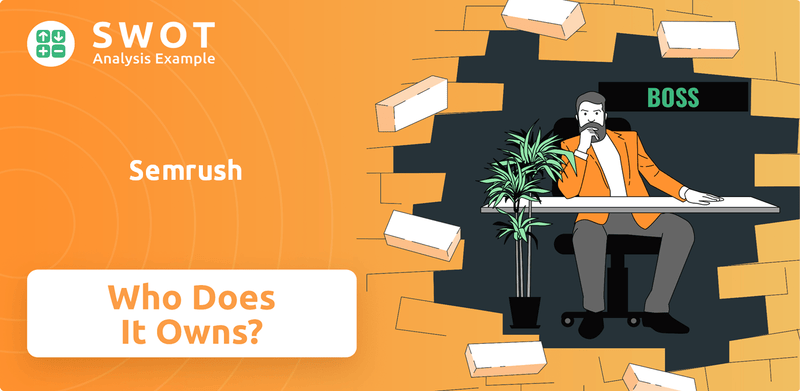
This analysis explores the Semrush company ownership from its Semrush founder roots to its current landscape. We'll examine the impact of its 2021 IPO, identifying key investors, and assessing the influence of the Semrush owner on the company's future. Discover the Semrush history and how the Semrush ownership structure shapes its market position and strategic initiatives, answering the question of who owns Semrush.
Who Founded Semrush?
The story of the Semrush company begins with its founders, Oleg Shchegolev and Dmitry Melnikov. They started building SEO tools in 2006, which eventually led to the formal establishment of the company in 2008. Understanding the Semrush owner and the evolution of its ownership structure provides crucial insights into the company's development and strategic direction.
Initially, the company operated informally before incorporating as Semrush Inc. in Delaware in 2012. This transition marked a significant step in formalizing the business. The company's journey reflects a classic startup trajectory, from a bootstrapped operation to a globally recognized platform.
In 2013, all shares of Semrush Inc. were transferred to Bootstrap Marketing Group Ltd., a Cyprus-based company, later renamed Semrush CY LTD in 2015. This restructuring is an important part of the Semrush history and its corporate evolution.
Oleg Shchegolev and Dmitry Melnikov founded Semrush in 2008.
They began developing SEO tools in 2006, with SEOquake as their initial offering.
The company was incorporated in the U.S. in 2012 and later restructured in Cyprus.
In April 2018, Semrush secured $40 million in funding from venture capital firms.
A dual-class share structure concentrates voting control with early stockholders, including founders.
The 2018 funding round was aimed at strategic partnerships rather than financial need.
Understanding the Semrush company ownership involves tracing its origins back to the founders and the early stages of the business. The company’s growth, from its inception to its current market position, showcases a strategic approach to funding and partnerships. For more insights into the company's strategy, check out this analysis of the Marketing Strategy of Semrush.
- The founders, Oleg Shchegolev and Dmitry Melnikov, still hold significant influence due to the dual-class share structure.
- The 2018 funding round, totaling $40 million, was a strategic move to enhance partnerships.
- The company’s early focus on SEO tools evolved into a comprehensive suite of marketing solutions.
- The restructuring in 2013 and 2015, moving the company to Cyprus, is a key part of its corporate history.
Semrush SWOT Analysis
- Complete SWOT Breakdown
- Fully Customizable
- Editable in Excel & Word
- Professional Formatting
- Investor-Ready Format
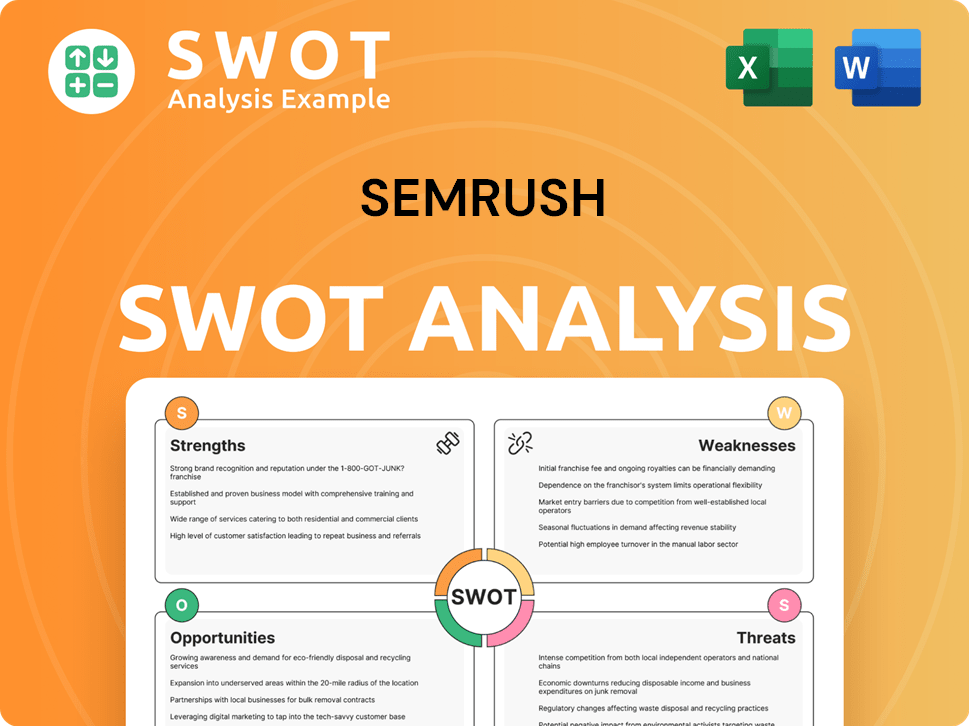
How Has Semrush’s Ownership Changed Over Time?
The evolution of the ownership structure of the company, now known as Semrush, began with the incorporation of Semrush Holdings, Inc. in December 2019. Through subsequent transactions, its subsidiaries, including Semrush CY, became wholly owned by Semrush Holdings, Inc. A significant shift occurred on March 25, 2021, when Semrush became a public company, listing on the New York Stock Exchange (NYSE) under the ticker symbol SEMR. The initial public offering (IPO) saw the sale of 10 million shares at $14 each, raising a total of $140 million. As of June 13, 2025, the market capitalization of Semrush Holdings stood at approximately $1.37 billion, reflecting the impact of its public listing and subsequent market performance.
The initial public offering (IPO) was a pivotal moment, transforming the company's ownership landscape by introducing institutional and public investors. The IPO provided capital for growth and expansion, while also increasing the company's visibility and market presence. The shift to public ownership has meant greater scrutiny and reporting requirements, impacting the company's strategic decisions and financial performance.
| Ownership Category | Percentage as of December 31, 2024 | Major Shareholders (March 30, 2025) |
|---|---|---|
| Individual Insiders | 52.3% | Greycroft LP (6.06%) |
| Institutions | 30.2% | RPM Capital Partners, LLC (6.06%) |
| Venture Capital/Private Equity | 11.7% | Siguler Guff & Company, LP (4.91%) |
| Private Companies | 5.84% | The Vanguard Group, Inc. (3.52%) |
| BlackRock, Inc. (2.49%) |
As of May 2025, institutional ownership in Semrush reached 51.69%, with 363 institutional owners holding a total of 72,231,963 shares. Key mutual fund holders as of February 28, 2025, included Vanguard Total Stock Market Index Fund (1.06% of total shares held) and Fidelity Small Cap Growth (1.00%). The concentration of voting power among pre-IPO shareholders, including directors, executive officers, and their affiliates, who held an aggregate of 88% of the voting power as of December 31, 2023, significantly influences company strategy and governance. Understanding the Semrush company profile is crucial for anyone looking to understand the company's ownership and future direction.
The ownership of Semrush is a mix of individual insiders, institutional investors, and venture capital firms, with a significant portion held by insiders.
- The IPO in 2021 marked a major shift, bringing in new investors and increasing market visibility.
- Institutional ownership is substantial, indicating confidence from major financial players.
- The influence of pre-IPO shareholders remains significant in company governance and strategy.
- Understanding the ownership structure is key to assessing the company's long-term prospects.
Semrush PESTLE Analysis
- Covers All 6 PESTLE Categories
- No Research Needed – Save Hours of Work
- Built by Experts, Trusted by Consultants
- Instant Download, Ready to Use
- 100% Editable, Fully Customizable
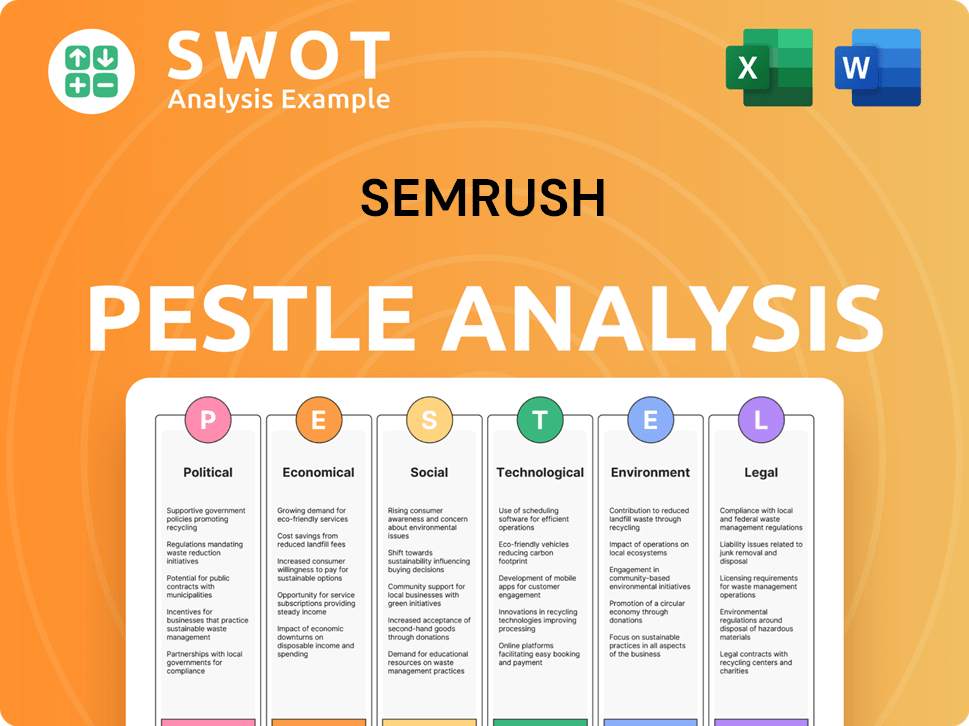
Who Sits on Semrush’s Board?
The current board of directors of the company plays a vital role in its governance. As of early 2025, key figures include Oleg Shchegolev, the co-founder, who continues to serve on the board alongside his role as CTO. William R. Wagner, who became CEO in March 2025, has been a board member since September 2022 and remains a Class II director. Recent changes have seen Trynka Shineman Blake joining the talent and compensation committee, Dylan Pearce joining the nominating and corporate governance committee, and Steven Aldrich taking on the role of chair of the talent and compensation committee, effective February 22, 2025. While specific affiliations of all board members are not fully detailed in the available information, these individuals are key in shaping the company's strategic direction.
The board's composition reflects a blend of experience and continuity. The staggered classes of directors, with each class elected for a three-year term, ensure a degree of stability and allow for a measured approach to leadership transitions. The board oversees the company's operations and makes critical decisions regarding its future. The board's structure is designed to provide oversight and guidance to the company's management team, ensuring that the company operates in the best interests of its shareholders.
| Board Member | Role | Notes |
|---|---|---|
| Oleg Shchegolev | Board Member, CTO | Co-founder |
| William R. Wagner | Board Member, CEO | Class II director since September 2022 |
| Steven Aldrich | Chair of Talent and Compensation Committee | Effective February 22, 2025 |
The company operates with a dual-class share structure, significantly influencing the voting power. Class B common stock holds ten votes per share, whereas Class A common stock, which is publicly traded, has one vote per share. Following the IPO, holders of Class B common stock controlled approximately 88% of the voting power, with founders, executive officers, and their affiliates holding a substantial portion. This structure allows those who held capital stock before the IPO, including the founders and executive officers, to control matters submitted to stockholders, including the election of directors. This concentration of voting power is a key aspect of the company's ownership structure. To understand more about the company's target audience, you can read the article on Target Market of Semrush.
The company's dual-class share structure concentrates voting power with Class B shareholders. This structure gives significant control to the founders and early investors. This impacts the decision-making process within the company.
- Class B shares have ten votes per share.
- Class A shares have one vote per share.
- The founders and executives hold a substantial portion of Class B shares.
- This structure allows for control over director elections and major decisions.
Semrush Business Model Canvas
- Complete 9-Block Business Model Canvas
- Effortlessly Communicate Your Business Strategy
- Investor-Ready BMC Format
- 100% Editable and Customizable
- Clear and Structured Layout
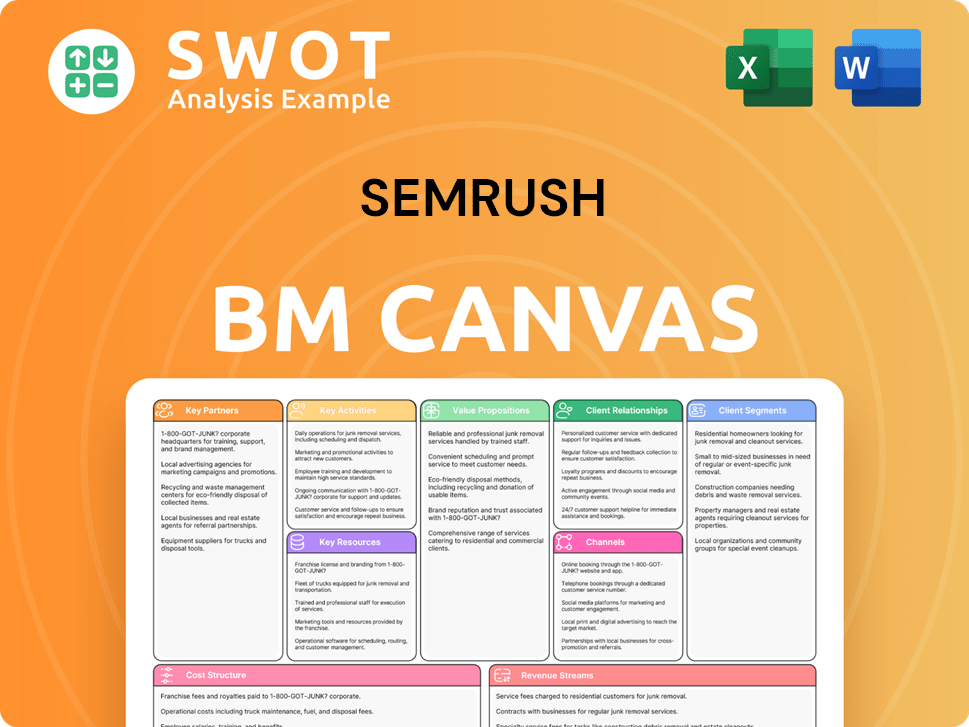
What Recent Changes Have Shaped Semrush’s Ownership Landscape?
Over the past few years, the ownership structure of the Semrush company has seen several shifts. Notably, the company went public in March 2021, changing from a private to a publicly traded entity. This transition marked a significant milestone in the Semrush history and impacted its ownership profile. Strategic acquisitions have also played a role, with the purchase of Third Door Media in October 2024, and Brand24 (58% stake) and Ryte earlier in 2024, expanding Semrush's offerings and reach. These moves reflect a strategy focused on both organic and inorganic growth to strengthen its market position.
Leadership changes have further influenced the company's trajectory. Semrush founder Oleg Shchegolev transitioned from CEO to CTO, effective March 10, 2025, with William R. Wagner taking over as CEO. While there was insider selling by executives, insiders still held a substantial 57.83% ownership as of May 2025. Institutional ownership has also grown, with 363 institutional owners holding a total of 72,231,963 shares as of May 2025, indicating increasing confidence from institutional investors in Semrush's long-term prospects. For more details, you can read about the Brief History of Semrush.
The recent developments highlight a period of strategic expansion and evolution for Semrush. The company continues to adapt its leadership and ownership structure to support its growth objectives, including strategic acquisitions. These changes are designed to enhance its market position and solidify its future in the competitive digital marketing landscape. These changes reflect a commitment to innovation and expansion, positioning the company for sustained growth.
Semrush is a publicly traded company, therefore, the ownership is distributed among various shareholders, including institutional investors, insiders, and the general public. Key figures include the founders and current management team.
Semrush was co-founded by Oleg Shchegolev and Dmitry Melnikov. Oleg Shchegolev is currently the Chief Technology Officer (CTO) of the company.
The current CEO of Semrush is William R. Wagner, who assumed the role on March 10, 2025. He took over from co-founder Oleg Shchegolev, who is now the CTO.
The Semrush ownership structure includes a mix of insider ownership (founders and executives), institutional investors, and public shareholders. Insiders hold a significant portion of the company's shares.
Semrush Porter's Five Forces Analysis
- Covers All 5 Competitive Forces in Detail
- Structured for Consultants, Students, and Founders
- 100% Editable in Microsoft Word & Excel
- Instant Digital Download – Use Immediately
- Compatible with Mac & PC – Fully Unlocked
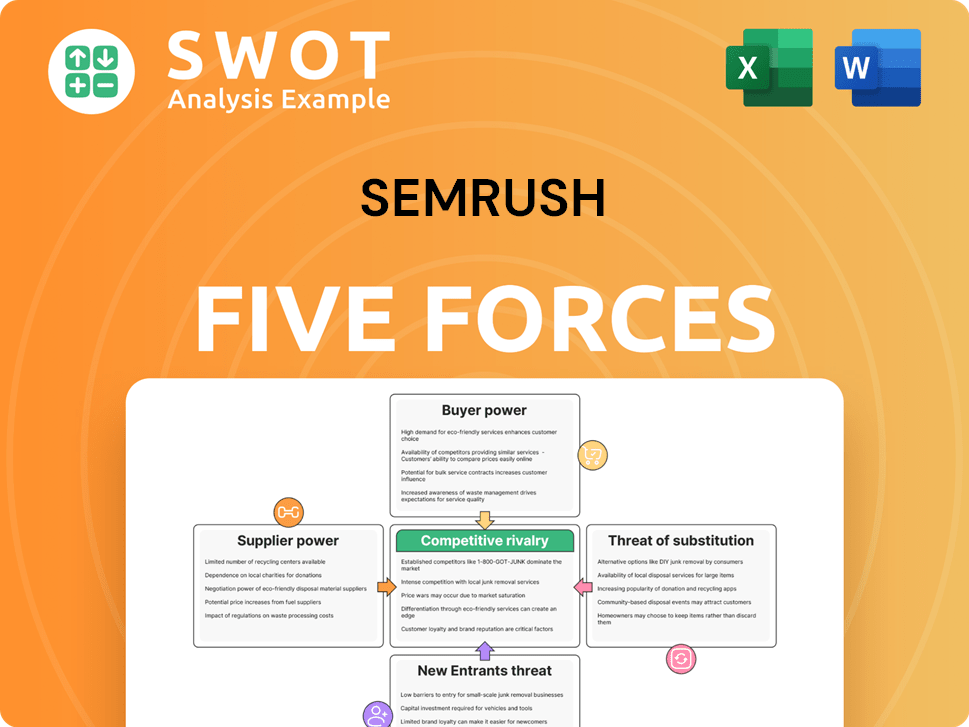
Related Blogs
- What are Mission Vision & Core Values of Semrush Company?
- What is Competitive Landscape of Semrush Company?
- What is Growth Strategy and Future Prospects of Semrush Company?
- How Does Semrush Company Work?
- What is Sales and Marketing Strategy of Semrush Company?
- What is Brief History of Semrush Company?
- What is Customer Demographics and Target Market of Semrush Company?
Disclaimer
All information, articles, and product details provided on this website are for general informational and educational purposes only. We do not claim any ownership over, nor do we intend to infringe upon, any trademarks, copyrights, logos, brand names, or other intellectual property mentioned or depicted on this site. Such intellectual property remains the property of its respective owners, and any references here are made solely for identification or informational purposes, without implying any affiliation, endorsement, or partnership.
We make no representations or warranties, express or implied, regarding the accuracy, completeness, or suitability of any content or products presented. Nothing on this website should be construed as legal, tax, investment, financial, medical, or other professional advice. In addition, no part of this site—including articles or product references—constitutes a solicitation, recommendation, endorsement, advertisement, or offer to buy or sell any securities, franchises, or other financial instruments, particularly in jurisdictions where such activity would be unlawful.
All content is of a general nature and may not address the specific circumstances of any individual or entity. It is not a substitute for professional advice or services. Any actions you take based on the information provided here are strictly at your own risk. You accept full responsibility for any decisions or outcomes arising from your use of this website and agree to release us from any liability in connection with your use of, or reliance upon, the content or products found herein.